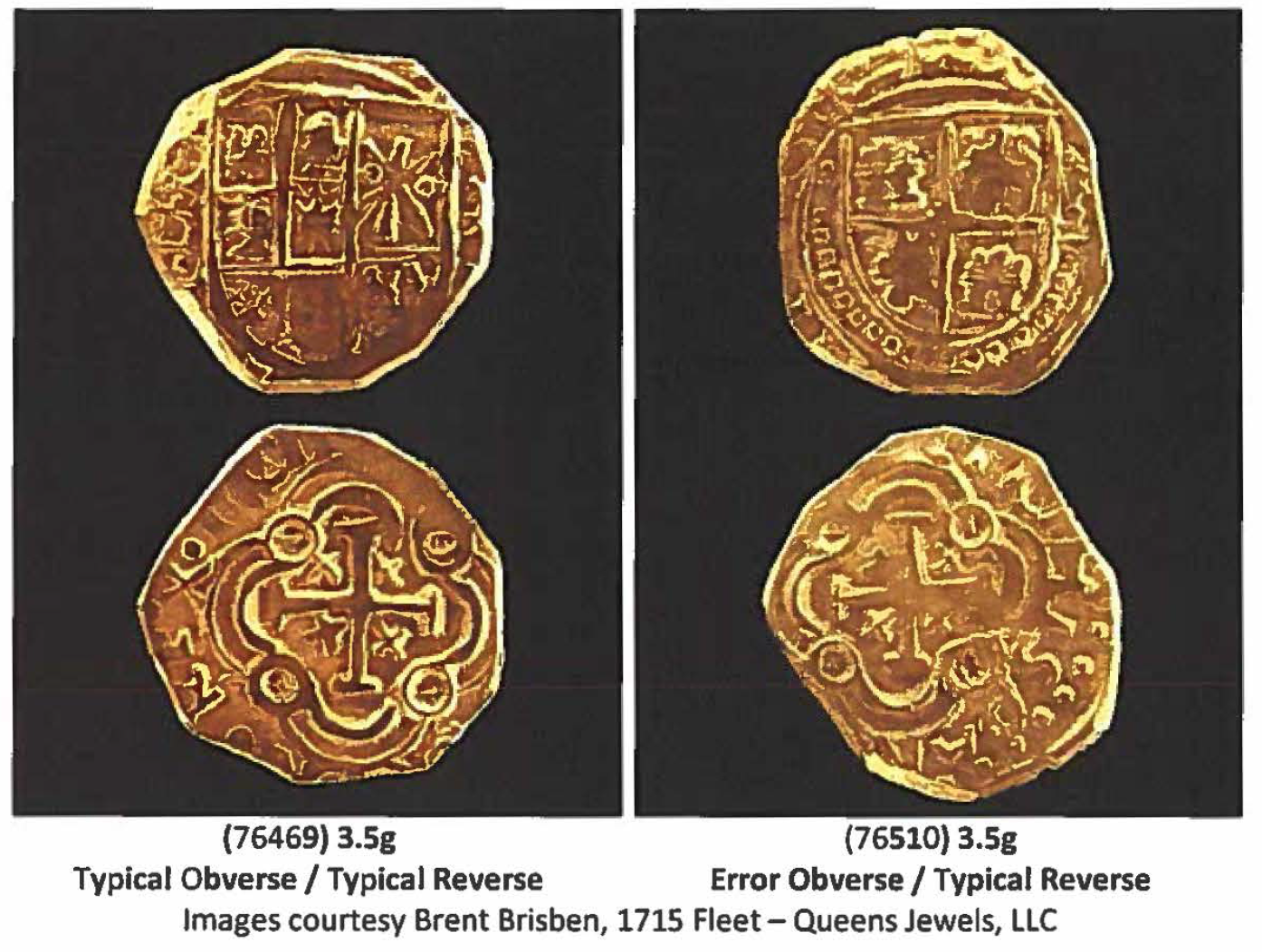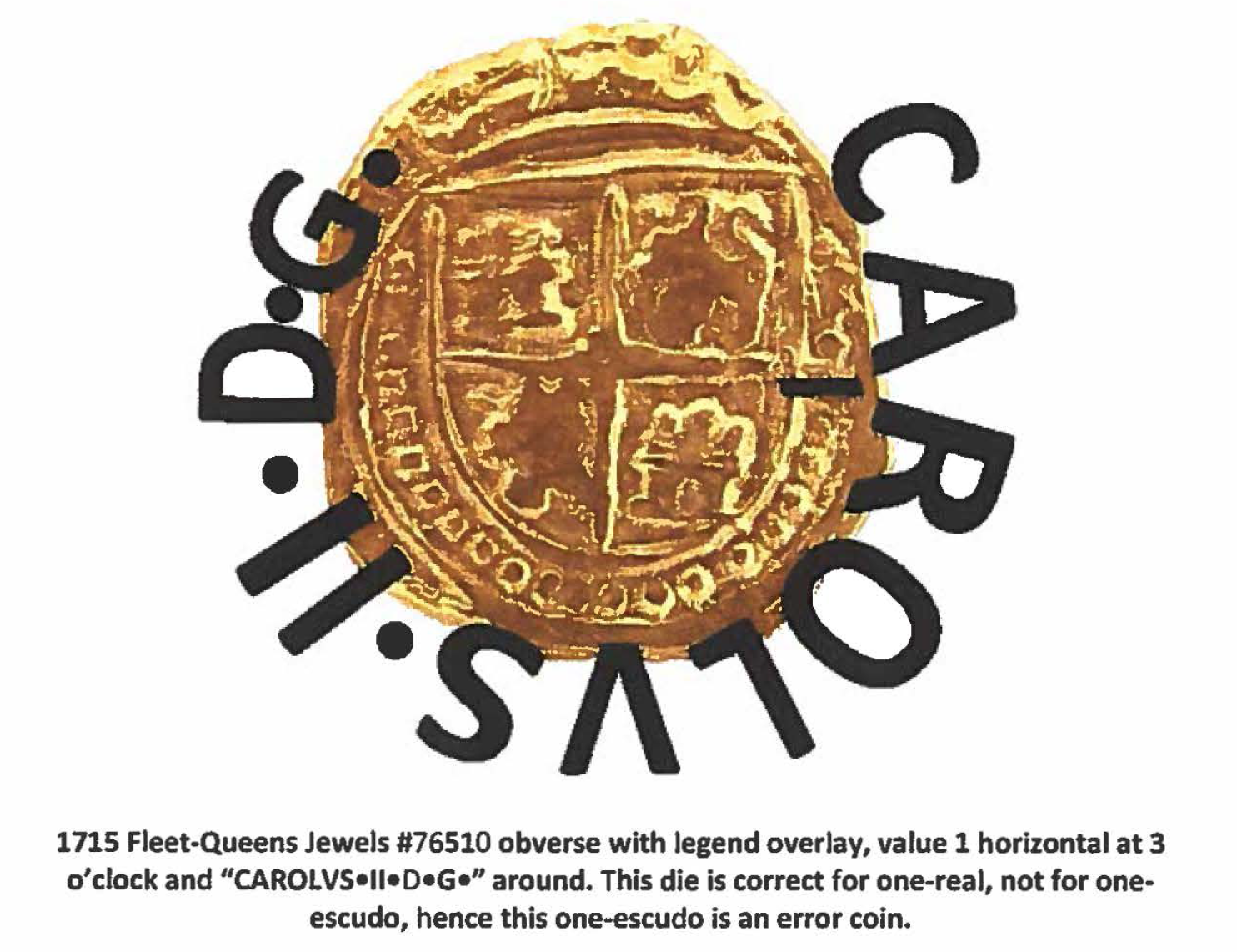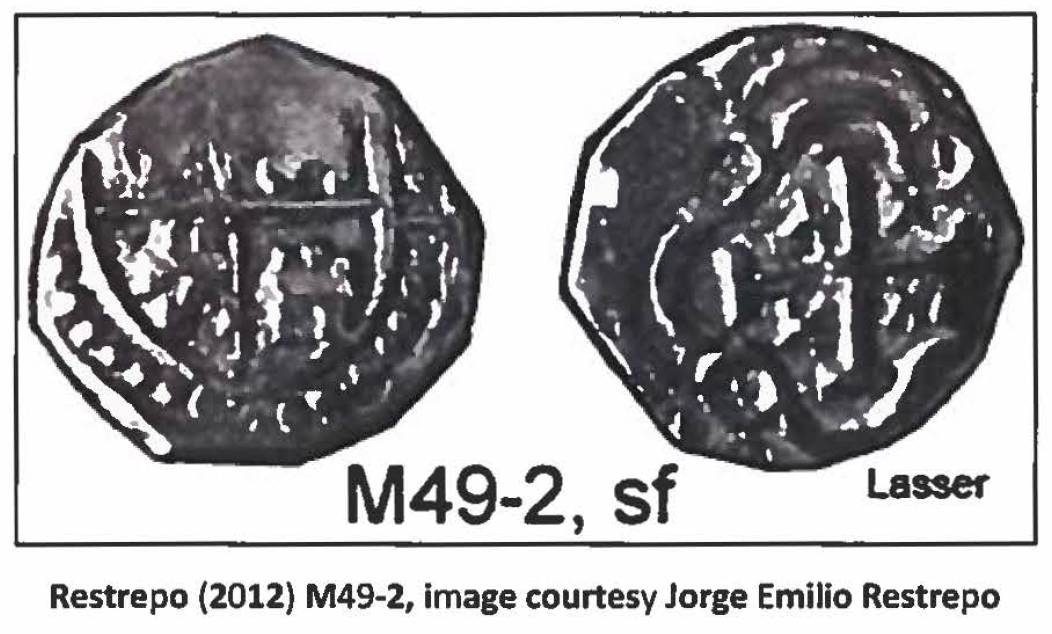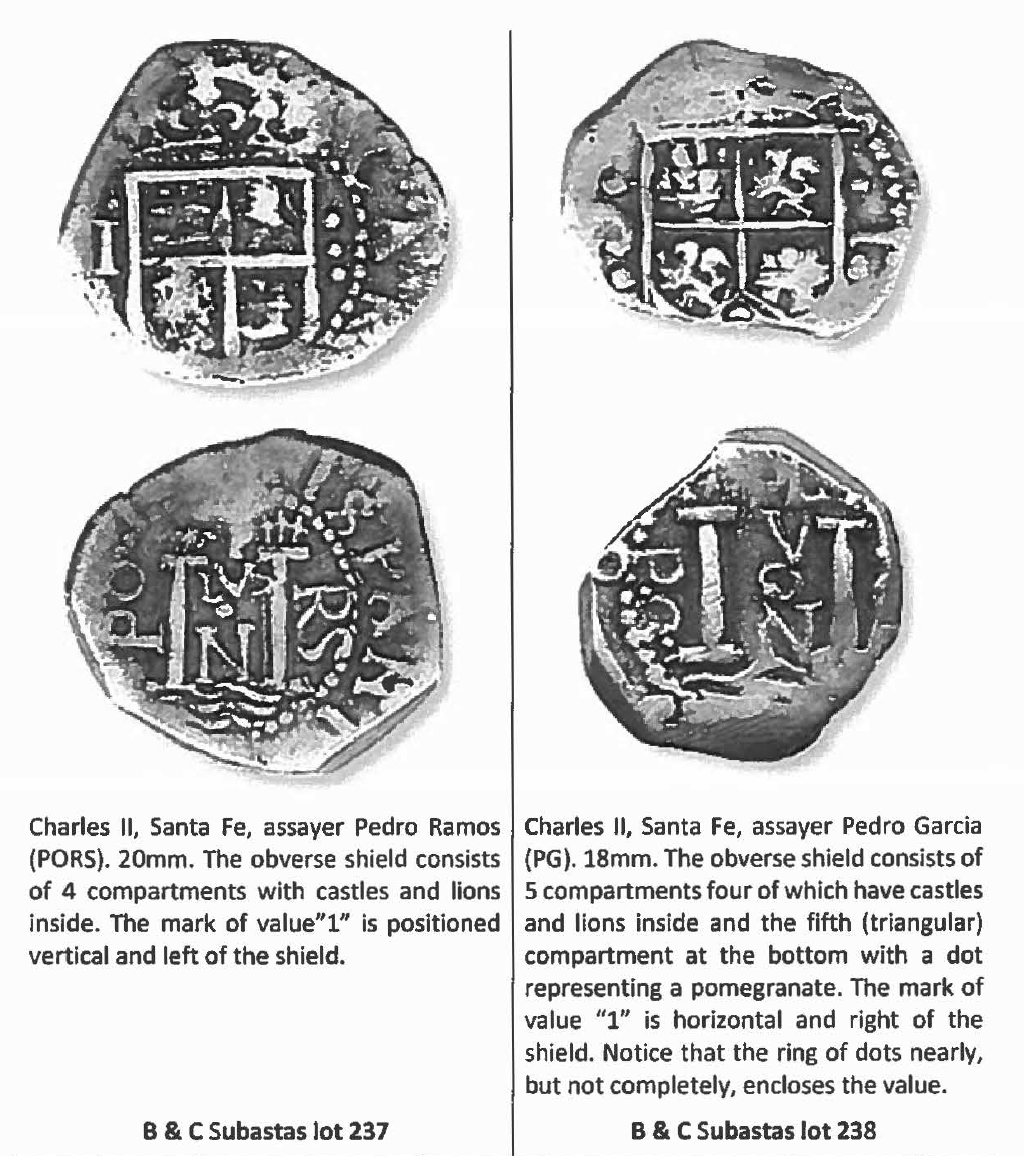by Herman Blanton
The “171S Fleet-Queens Jewels, LLC” treasure salvage operations recovered a cache of gold escudos on 13-July-2013 on a site called “Corrigans” at Sebastian Inlet near Wabasso Beach, Fl. Other artifacts including a silver spoon, olive jar pottery shards, musket balls and spikes were found in the vicinity. About a week later three additional coins were found. Of the fifty-one specimens all are one escudos save a lone two-escudo doubloon. Operations manager Brent Brisben submitted a two page report of this find, including a coin data table, which appeared Ernie Richards’ PLVS VLTRA Newsletter 2nd Quarter 2014. The fact that all save one of the specimens recovered from the hole are one-escudos is significant. According to historical documentation the one-escudo gold along with silver two-reales, one-real and half-real were to be produced for local use while the larger twoescudo gold and silver eight-reales and four-reales were produced for export.
… para que se labren en el/a escudos sencillos, rea/es de a dos, sencillos y medias, para que con esta moneda menuda se pueda tratar y comerciar entre Jos vecinos, quedandose en la tierra, sin que se pueda sacar de el/a… Vuestra Majestad mandar Jo que fuere servido. En Madrid, a 27 de noviembre, 1618. (Friede: document 2, p. 48)
It seems that this cache of one escudos may have been a privately owned treasure. Of course we may never know how it came that this group of one escudos was gathered In a sea floor crack.
The report highlighted a 1701 dated escudo from Santa Fe with a distinctive design. This immediately brought to mind another specimen whose attribution I’ve long held as problematic. This prior specimen was the only one known to me before Brisben’s report; it is Lasser and Restrepo M49S-1(pp.67, 131) where it is identified as Philip IV (reigned 1621- 1665). This coin is not in the prior Spanish language version Restrepo and Lasser (1998) so it seems that Lasser come upon his specimen between 1998-2000. My doubt about the attribution is due to the design of the obverse shield which is quite unlike any other Santa Fe gold coin. With the publication of a clear photo of the 1715-Fleet Queens Jewels specimen and some thinking about it an attribution developed. In my review of the literature I found a concurring attribution published a decade ago (Menzel).
The designs of Spanish gold and silver intentionally differ from another by royal decrees. As a consequence of the Potosi scandal, in which the integrity of the silver coinage became an issue in global trade and an embarrassment to Spain, the king ordered a redesign of the silver produced in the viceroyalty of Peru. The royal decree of 22-December-1650 ordered a new design for the silver coins, that being the placement of the armsInsignia of a family or country, containing specific figures and colors and passed along through hereditary lineage. of Castile and Leon on one side and two columns on the other with the motto Plvs Vitro in-between the columns (Proctor and Blanton). The Santa Fe mint complied with the decree beginning in 1651 even though there was no malfeasance there.
… ordeno la forma de/ cuflo fuerte que no imite de/ de hasta aora sino que por la una parte se pongan las armas de Castilla y Leon y por la otra dos columnas con el Plus Ultra en media procurando que no sean re/evadas y tambien sea de pone el aflo, la casa y el nombre de/ ensayador con gran distinci6n y c/aridad de manera que se pueda leer advirtiendo se estampe muy bien los sel/os de la moneda de suerte que se reconozca por ambas partes pues esto es tan conveniente para que tenga di/erencia de las de antes …
Below are two 1701 dated Santa Fe escudos from the recovered cache. One is a typical Santa Fe design (76469) and the other the subject coin (76510). The typical Santa Fe escudo of the 1715 fleet era has an obverse shield with Castile and Le6n (castle and lion, two each) at the top left. At top right is the armsInsignia of a family or country, containing specific figures and colors and passed along through hereditary lineage. of Aragon/Two Sicilies where three vertical members of Aragon are constricted at the midpoint by two dots representing eagles. Along the bottom of the shield are three compartments; the center is a small shield of Flanders & Tyrol (which appears empty on this specimen) and either side are three lily flowers in the form of crosses (x). The subject coin 76510 has a shield as described by the decree of 1650 showing simply the armsInsignia of a family or country, containing specific figures and colors and passed along through hereditary lineage. of Castile and Leon; this die is for a silver one-real coin.

The reverses of these two are very similar, disputably the same die. Notice the four lily flowers appearing as crosses (x) positioned between the cross armsInsignia of a family or country, containing specific figures and colors and passed along through hereditary lineage. of the central design. The two-escudo reverse design at the time (c. 1700) used a more elaborate shape of lily flower resembling scissors. The simple cross design shows that one escudo dies were used for striking these specimens as opposed to two-escudo dies used on one-escudo planchets (coin blanks). Following is an image of the Lasser one-escudo, indubitably the same design as coin 76510.

Below are two Santa Fe one-reals of Charles II (reigned 1665-1700) designed according to the decree of 1650 with shield of Castile and Leon on the obverse. These are very rare so there are not many available for comparison. One of the coins is assayer Pedro Ramos whose term ended in 1676 and the other is assayer Pedro Garcia (1678-86, 1687-91).
Summary
As I write this in June 2014 the 1715 Fleet-Queens Jewels and Lasser specimens are the only examples of this error known to me. Based on the four compartment design, which omits the pomegranate, the Lasser specimen may have led some to attribute this coin to Cartagena. However, since the 1715 Fleet-Queens Jewel specimen is dated 1701 we can be sure it is Santa Fe as Cartagena closed in 1635 except for some weeks in 1655 when only silver was produced. Further study could be done to compare the castle and lion punches on the obverse with those used on the known one-real coins and to compare the reverses of coins 76469 and 76510. According to Brisben the State of Florida received coin 76510 in the division of treasure.
References [and citations found]
B & C Subastas. 2a. Subasta de Bi/letes y Monedas de Colombia. Bogota, diciembre 6 de 2005. Club Filatelico de Bogota. (All silver cobs except lots 230 and 232 from collection of Don Alberto Lozano Villegas.)
Brisben, Brent. “Another ‘Bonanza’ Year on the 1715 Fleet” in PLVS VLTRA Newsletter Vol. 32, No. 2 (2nd Quarter, 2014): 6-7. [Bogota, illustrated on p. 6) Brown, Mike. “!Mas Oro! On the 1715 Fleet” in PLVS VLTRA Newsletter Vol. 31, No. 3 (3rd Quarter, 2013): 7.
Calico, X. Numismatica Espanola, Cata/ago de todas las monedas emitidas desde Los Reyes Catolicos Hasta Juan Carlos I. 1474 a 2001. Barcelona: Aureo & Calico., 2008. [Felipe IV, cartagena, illustrated & numbered as Tipo 42, numero 199 on page 302)
Friede, Juan. Documentos Sabre la Fundacion de la Casa de Moneda en Santa Fe de Bogota (1614-1635) Conservados en el Archivo General de Indios, Sevilla, Transcritos y Anotados. Bogota: Publicaci6nes del Banco de la Republica. 1963.
Lasser, Joseph R. and Jorge Emilio Restrepo. The Cob Coinage of Colombia. New York: 2000. [Philip IV, Santa Fe, illustrated & numbered as M49S-1 on pp. 67, 131)
Menzel, Sewall. Cobs, Pieces of Eight and Treasure Coins, The Early Spanish-American Mints and Their Coinages 1536-1773. (New York: American Numismatic Society. 2004. [Philip IV, Santa Fe, illustrated & numbered as SF-58 on p. 403. Correctly identified as 1 escudo muled with 1-real obverse]
Proctor, Jorge A. and Herman Blanton. ”The Illegal Mint Office of Cartagena, 16S5″ in Numismatics International Bulletin, Volume 47 Numbers 1I2, January/ February 2012, pp. 2-20.
Restrepo, Jorge Emilio. Monedas de Colombia 1619-2006 Apuntes de un Co/leccionista. Medellin: 2006. [Felipe IV, Santa Fe, illustrated & numbered as M49-2 on p.88)
Restrepo, Jorge Emilio. Monedas de Colombia 1619-2006 Apuntes de un Co//eccionista 2nd Edition. Medellin: 2007. [Felipe IV, Santa Fe, illustrated & numbered as M49-2 on p.88)
Restrepo, Jorge Emilio. Monedas de Colombia 1619-2006 Apuntes de un Co//eccionista 3rd Edition. Medellin: 2009. [Felipe IV, Santa Fe, illustrated & numbered as M49-2 on p.88)
Restrepo, Jorge Emilio. Coins of Colombia {Spanish Colonial and Republican) 1619-2012 (Monedas de Colombia 1619-2012) 4th edition, 1st English edition. Medellin: 2012. [Philip IV, Santa Fe, illustrated & numbered as M49-2 on p.84)
Soli Deo gloria

